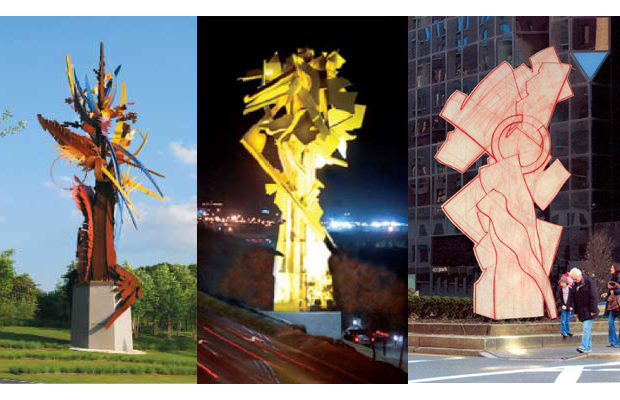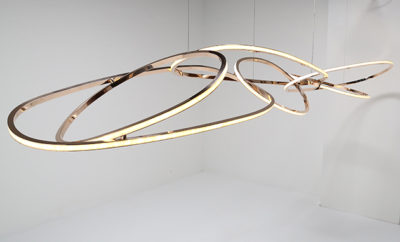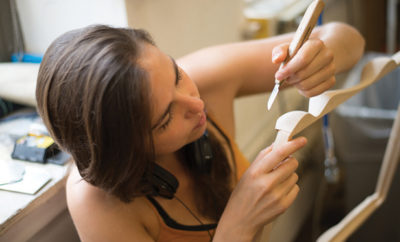
Exhibition
Pattern of Chaos
ALBERT PALEY PREPARES FOR PARK AVENUE

Albert Paley’s installation of monumental series of new sculptures on Park Avenue is his largest body of work shown in New York City in more than two decades. The Park Avenue project, on view from June 29 to November, will be documented by an exhibition of developmental drawings and sculpture maquettes at Gerald Peters Gallery, New York, opening in September, and in a book, written by Patterson Sims published at the same time. It is a seminal project for an artist who has been busy at work for more than forty years.
Paley was born in Philadelphia and graduated from the Tyler School of Art at Temple University where he majored in sculpture and minored in metalwork. In 1969, he moved to Rochester, New York to teach at the Rochester Institute of Technology, where he is now a distinguished professor. He has lived and worked there since. His studio, immense and impressive, is a 40,000 square foot facility with the capacity to produce his furniture and design objects, as well as large-scale sculptures; it also contains a drawing studio and an extensive archive.
He focused his early career in the 1960s and 1970s on making jewelry. Paley’s jewelry has the restraint and delicacy of the masterful work of René Lalique, but the freedom and expressiveness of mid-century artist jewelry, like that of Alexander Calder. These pieces are wrought with compressed physicality and sensual beauty.
By the 1980s Paley had established himself as a more versatile artist, becoming well known for his large-scale metalwork, including furniture designs and elaborate architectural installations. His furniture exploits his proficiency in handling metal and his mastery at iron forging. Made on commission or in editions, Paley’s furniture is sculptural and shows a heavy art nouveau influence, but one that has been abstracted and stylized with an emphatic baroque tone.
His architectural and sculptural installations, on sites as far-flung as Hawaii, Alaska, and Tyson’s Corner, Virginia, exhibit a wider range of formal qualities. Since completing the Portal Gates at the Smithsonian’s Renwick Gallery in 1974, Paley has completed more than ninety site-specific works and public sculptures. Some, like Strong Museum Sculpture (1982), in Rochester, are composed of unified, geometric forms. Others, like Confluence (1990) for the Birmingham Museum of Art in Alabama or Synergy (1987) at Museum Towers in Philadelphia, are a combination of rectilinear columns and other vertical elements interrupted by woven drapery and ribbon-like banners. Aurora (1990), a significant work in Paley’s development, installed in the plaza at the Roanoke Regional Airport in Virginia, is more natural. Here, opening to the sky is a colorful burst of torn petal-like sheets above a green and blue ribbon, raised on a tapered column of fragmented supports.

Paley, at center in his Rochester studio, has spent the last two decades working on a range of projects including architectural installations and full-scale sculptures, such as The Beckoning (above), 2008, for National arbor near Washington D.C., and Evanesce (below), 2009, for Monteray, Mexico.
Paley has spent the last two decades expanding his practice to include full-scale sculptures on an even grander scale. Installed in a dedicated green space and cultural corridor in Monterrey, Mexico, Evanesce (2009) is an energetic tower built of broken shards and sheets of yellow-painted steel, rising in height to more than one hundred feet. Other notable recent works include Animals Always (2006) for the Saint Louis Zoo and National Cathedral Gate (2007) in Washington, D.C. For the zoo Paley created an elaborate figural installation, 130 feet wide, teeming with animals within a lush natural setting. Interestingly, it relates to plans Paley undertook in 1985 for a gate for New York’s Central Park Zoo, a project that was sadly canceled due to an eventual lack of funding. The arched and ceremonious gate for the National Cathedral is layered with symbolic visual references, with roots in the Gothic revival tradition of the late nineteenth century. In a defining gesture, Paley draws the eye upward with the inclusion of a gilded ring set above the layered crucifix-form handle.

Collectors and institutions are continually drawn to Paley’s work. In addition to the Renwick, it is held in the permanent collections of the Victoria and Albert Museum in London, the Philadelphia Museum of Art, and the Metropolitan Museum of Art, to name a very few. That said, he is sometimes challenged to explain the motivation behind the artistic choices he has made over the years. “I feel that questions about the evolution and development of one’s work should deal only with one’s own sense of integrity and insight,” he says. “You create the environment to experience something you haven’t experienced before, through which new possibilities evolve.” He elaborates, “There’s nothing to be gained in something which is resolved and understood. Just to repeat your own cliché is the worst thing that can happen.”
Paley is often aligned with the studio-craftsman—the designer-artist—alongside contemporaries such as Judy Kensley McKie, Wendell Castle, or Michael Coffey. Take just one aspect of his work, and the comparisons are deserved. But witnessing the entirety of Paley’s diverse activities as artist, sculptor, craftsman, and designer, one sees that his artistic endeavor is more akin to American and British artists such as Frank Stella or Sir Anthony Caro, both recognized as key figures in contemporary sculpture, and each of whose innovative and influential careers took shape in the 1960s. For Paley, it is expression on a larger scale and larger stage.
And there is no stage larger than New York City. The thirteen sculptures for Park Avenue are placed throughout the passage from the Park Avenue Armory at 67th Street down to 52nd Street. They are executed in a range of materials, such as CorTen, stainless, and weathering steel, some finishes bright and silver and others with a dark patina. Still others are painted in a palette of bright colors and polychrome. With a range of formal qualities, each is sensitive to the specific site where it is placed. Paley remarks, “Sometimes I address the harmony and the consistency of the site and other times I deal in contrast. Some are more logically or geometrically inclined where others are more lyrical.” Altogether they are like an index of Paley’s visual language.
Languorous Repose was designed for 66th Street. Paley says it “deals with an intricate lace of curvilinear lines and planes, so I selected stainless steel as the material. I wanted the subtlety of curves and play of shadow as it changes and dissipates through the day and the linear quality of the contours carried by the light.” Referring to Counter Balance at 58th Street, he comments: “It is very architectonic with large interlocking forms, one to the other. I wanted to deal with the sense of volume and solidity and the play of silhouette. I made it in CorTen steel, which has a matte dark patina, which accentuates those qualities. The largest piece, installed before the Seagram Building, is called Progression and is different from anything else.”

Paley on Park Avenue will comprise thirteen sculptures from 67th Street to 52nd Street. Executed in a range of materials and styles, the proposed sculptures include Lanjuorous Repose and Counter Balance (pictured), both shown with Paley’s preliminary drawings.
Asked about his goals for the Park Avenue installation, Paley remarks that the challenge is creating an artistic connection between his work and an uninitiated audience: “You’re dealing with the pattern of chaos. You create that place in time and that intimacy of experience. There’s the immediate thing of grabbing your attention, then the acknowledgment that something is there, all before giving attention to it.”
All the challenges aside, Albert Paley is an artist who is sincere in his effort to create a lasting achievement through his art. There is a generosity in his work stemming from an overall belief that people are open to the unexpected artistic encounter. Asked to elaborate on the artist’s role, especially in the context of such a dense urban environment as New York City, he explains, “I can’t be responsible for the viewer. The sculptures are non-literal and we are dealing with a visual undertaking.” After a pause he clarifies, “I feel it is not an intellectual dialogue but an emotional response, which the artist engages. I try to accentuate that condition through the interplay of form and color and light.”












